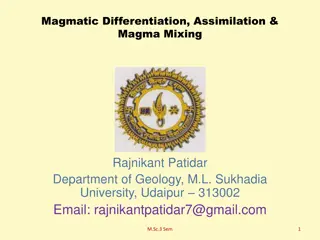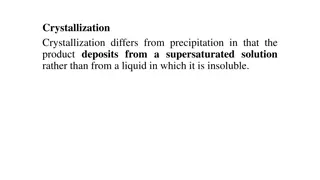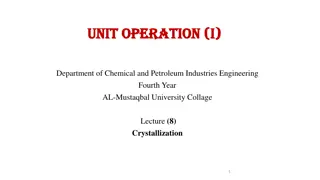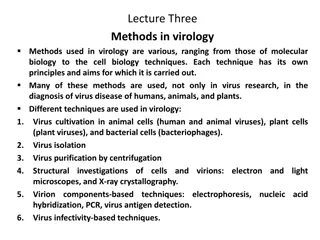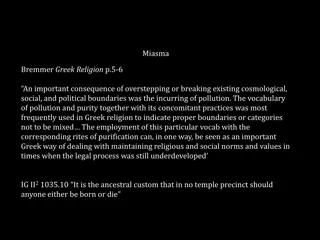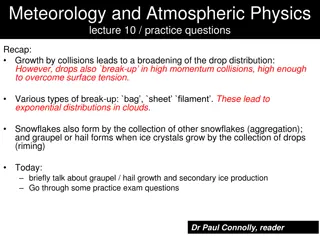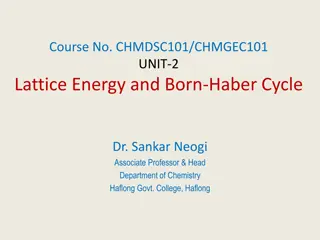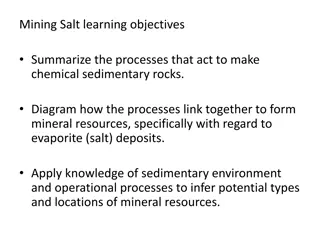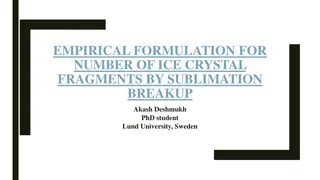Crystallization Principles in Chemical Engineering: Understanding Crystal Formation and Purification Methods
Crystallization is a key process in chemical engineering, involving the formation of solid particles within a homogeneous phase to obtain pure chemical substances. This article discusses the principles of crystallization, the importance of crystal size control, equilibria in the process, and the concept of magma in industrial crystallization. The control of crystal size distribution is crucial for achieving high purity and the desired physical properties of the final product. Understanding the solubility curves of different substances plays a vital role in optimizing crystallization processes.
Download Presentation

Please find below an Image/Link to download the presentation.
The content on the website is provided AS IS for your information and personal use only. It may not be sold, licensed, or shared on other websites without obtaining consent from the author.If you encounter any issues during the download, it is possible that the publisher has removed the file from their server.
You are allowed to download the files provided on this website for personal or commercial use, subject to the condition that they are used lawfully. All files are the property of their respective owners.
The content on the website is provided AS IS for your information and personal use only. It may not be sold, licensed, or shared on other websites without obtaining consent from the author.
E N D
Presentation Transcript
(Prof.) D.K.MEHTA, ASSISTANT PROFESSOR, CHEMICAL ENGINEERING DEPARTMENT, L.E.COLLEGE-MORBI
TOPIC:- CRYSTALLISATION SUBJECT:-Mass Transfer Operation-I SUBJECT CODE:-3150501
Crystallization Principles Crystallization is the formation of solid particles within a homogeneous phase. Crystallization wide use has a twofold basis : (1) a crystal formed from an impure solution is itself pure (unless mixed crystals occur) (2) crystallization affords a practical method of obtaining pure chemical substances in a satisfactory condition for packaging and storing.
Crystallization Principles Magma:- In industrial crystallization from solution, the two-phase mixture of mother liquor and crystals of all sizes, which occupies the crystallizer and is withdrawn as product, is called a magma. In practice, much of the retained mother liquor is separated from the crystals by filtration or centrifuging and the balance is removed by washing with fresh solvent. The effectiveness of these purification steps depends on the size and uniformity of the crystals.
Importance of crystal size Good yield and high purity are important objectives in crystallization, but the appearance and size range of a crystalline product also are significant. If the crystals are to be marketed as a final product, customer acceptance requires individual crystals to be strong, non aggregated, uniform in size, and noncaking in the package. For these reasons, crystal size distribution must be under control; it is a prime objective in the design and operation of crystallizers.
Equilibria Equilibrium in crystallization processes is reached when the solution is saturated, and the equilibrium relationship for bulk crystals is the solubility curve. The solubility of extremely small crystal is greater than that of crystals of ordinary size. Curves showing solubility as a function of temperature are given in Figure shown in next slide.
Equilibria Most materials follow curves similar to curve 1 for KNO3; that is, their solubility increases more or less rapidly with temperature. A few substances follow curves like curve 2 for NaCl, with little change in solubility with temperature. Others follow curve 3 for MnSO4.H2O which is called an inverted solubility curve, which means that their solubility decreases as the temperature is raised.
Supersaturation In the formation of a crystal two steps are required : (1) the birth of a new particle which as known as nucleation. (2) crystal growth to microscopic size. The driving potential for rates of both is supersaturation. Supersaturation is the concentration difference between that of the supersaturated solution in which the crystal is growing and that of a solution in equilibrium with the crystal.
Method to generate supersaturation (1) Cooling (2)Evaporation (3) Salting (4) Precipitation (1) Cooling:- If the solubility of the solute increases strongly with increase in temperature, as is the case with many common inorganic salts and organic substances, a saturated solution becomes supersaturated by simple cooling and temperature reduction.
Method to generate supersaturation (2)Evaporation:- If the solubility of the solute is relatively independent of temperature, as is the case with common salt, supersaturation may be generated by evaporating a portion of the solvent. (3) Salting:- If neither cooling nor evaporation is desirable, as when the solubility is very high, supersaturation may be generated by adding a third component. The third component may act physically, with the original solvent, a mixed solvent in which the solubility of the solute is sharply reduced. This process is called salting.
Method to generate supersaturation (4) Precipitation:- If nearly complete precipitation is required, a new solute may be created chemically by adding a third component that will react with the original solute and form an insoluble substance. This process is called precipitation.
Nucleation The rate of nucleation is the number of new particles formed per unit time per unit volume of magma or solids-free mother liquor. Nucleation refers to the birth of very small bodies of a new phase within a supersaturated homogeneous existing phase. Nucleation is a consequence of rapid local fluctuations on a molecular scale in a homogeneous phase that is in a state of metastable equilibrium.
Primary nucleation The basic phenomenon is called homogeneous nucleation, which is further restricted to the formation of new particles within a phase uninfluenced in any way by solids of any sort, including the walls of the container or even the most minute particles of foreign substances. When solid particles of foreign substances do influence the nucleation process by catalyzing an increase of nucleation rate at a given supersaturation or giving a finite rate at a supersaturation where homogeneous nucleation would occur only after a vast time. This is called heterogeneous nucleation.
Homogeneous nucleation In crystallization from solution, homogeneous nucleation almost never happens, except perhaps in some precipitation reactions. Crystal nuclei may form from molecules, atoms or ions. Because of their random motion, in any small volume several of these particles may associate to form what is called a cluster. A cluster is a loose aggregation which usually disappears quickly. Occasionally enough particles associate into what is known as an embryo.
Homogeneous nucleation In embryo, there are the beginnings of a lattice arrangement and the formation of a new and separate phase. For the most part, embryos have shot lives and revert to clusters or individual particles. If supersaturation is large enough, an embryo may grow to such a size that it is in thermodynamic equilibrium with the solution, which is known as nucleus.
Homogeneous nucleation Nucleus Is the smallest assemblage of particles that will not redissolve and grow to form a crystals. Few to several hundred particles are needed for stable nucleus. For water this number is 80. Cluster embryo nucleus crystals
Crystal growth Crystal growth is a diffusional process, modified by the effect of the solid surfaces on which the growth occurs. Solute molecules or ions reach the growing faces of a crystal by diffusion through the liquid phase. The usual mass-transfer coefficient ky applies to this step. On reaching the surface, the molecules or ion must be accepted by the crystal and organized into the space lattice. The reaction occurs at the surface at a finite rate. Neither the diffusional nor the interfacial step will proceed unless the solution is supersaturated.
Caking of crystals When crystals are improperly stored cake or clumps of crystal are formed and it is known as caking of crystals. Factors affecting caking:- 1. Shape and Size of crystals. 2. Melting point of crystals. 3. Impurities in crystals. 4. Humidity 5. Temperature fluctuations 6. Time of exposure
Prevention of caking Crystal must be more spherical. Crystals must be of large size, more void and must be of narrow size distribution. Crystals must have highest possible humidity. Crystals must be covered with powdery inert material to prevent absorption of moisture e.g., table salt is coated with magnesia or tricalcium phosphate.
Example A solution consisting of 30% MgSO4and 70% H2O is cooled at 150C. During cooling, 5% of the total water in the system evaporates. Concentration of mother liquor is 24.5% anhydrous MgSO4and 75.5% H2O. How many kilograms of MgSO4 .7H2O crystals are obtained per 1000 kg of original mixture?
Yields In many industrial crystallization processes, the crystals and mother liquor are in contact long enough to reach equilibrium, and the mother liquor is saturated at the final temperature of the process. The yield of the process can then be calculated from the concentration of the original solution and the solubility at the final temperature. If appreciable evaporation occurs during the process, this must be known or estimated.
Yields When the rate of crystal growth is slow, considerable time is required to reach equilibrium. this is especially true when the solution is viscous or where the crystals collect in the bottom of the crystallizer so there is little crystal surface exposed to the supersaturated solution. In such situations, the final mother liquor may retain appreciable supersaturation, and the actual yield will be less than that calculated form the solubility curve. If the crystals are anhydrous, calculation of the yield is simple, as the solid phase contains no solvent.
Crystallization Equipment Commercial crystallizers may operate either continuously or batch wise. Except for special applications, continuous operation is preferred. The first requirement of any crystallizer is to create a supersaturated solution, because crystallization cannot occur without supersaturation.
Crystallization Equipment Three methods are used to produce supersaturation. (1) solutes like potassium nitrate and sodium sulfite are much less soluble at low temperatures than at high temperatures, so supersaturation can be produced simple by cooling. (2) When the solubility is almost independent of temperature, as with common salt or reduces as the temperature is raised, supersaturation is developed by evaporation. (3) In intermediate cases a combination of evaporation and cooling without evaporation, evaporation without cooling, or a combination of both.
Continuous Vacuum Crystallizers Most modern crystallizers fall in the category of vacuum units fin which adiabatic evaporative cooling is used to create supersaturation. Continuous vacuum crystallizer with the conventional auxiliary units for feeding the unit and processing the product magma. The magma circulates from the cone bottom of the crystallizer body through a downpipe to a low-speed low-head circulating pump, passes upward through a vertical tubular heater with condensing steam in the shell, and thence into the body.
Continuous Vacuum Crystallizers The heated stream enters through a tangential inlet just below the level of the magma surface. This imparts a swirling motion to the magma, which facilitates flash evaporation and equilibrates the magma with the vapor through the action of an adiabatic flash. The supersaturation thus generated provides the driving potential for nucleation and growth.
Continuous Vacuum Crystallizers Feed solution enters the downpipe before the suction of the circulating pump. Mother liquor and crystals are drawn off through a discharge pipe upstream from the feed inlet in the downpipe. Mother liquor is separated from the crystals in a continuous centrifuge recycled to the downpipe. The crystals are taken off as a product or for further processing.
Draft tube-baffle crystallizer The crystallizer body is equipped with a draft tube, which also acts as a baffle to control the circulation of the magma, and an upward- directed propeller agitator to provide a controllable circulation within the crystallizer. An additional circulation system, outside the crystallizer body and driven by a circulating pump, contains the heater and feed inlet. Product slurry is removed through an outlet near the bottom of the conical lower section of the crystallizer body.
Draft tube-baffle crystallizer For a given feed rate, both the internal and external circulations are independently variable and provide controllable variables for obtaining the required CSD ( Crystal Size Distribution). It may have elutriation leg below the body to classify the crystals by size and may also be equipped with a baffled settling zone for fines removal. Part of the circulating liquor is pumped to the bottom of the leg and used as a hydraulic sorting fluid to carry small crystals back into the crystallizing zone for further growth.
Draft tube-baffle crystallizer The discharge slurry is withdrawn from the lower part of the elutriation leg and sent to a filter or centrifuge, and the mother liquor is returned to the crystallizer. Unwanted nuclei are removed by providing an annular space or jacket. This annular space provides a settling zone, in which hydraulic classification separates fine crystals from larger ones by floating them in an upward-flowing stream of mother liquor, which is withdrawn from the top of the settling zone.
Swenson walker crystallizer It is continuous type crystallizer. It works on principle of supersaturation by cooling. It consists of U-shaped open trough with a semi cylindrical bottom. A water jacket is welded to the outside of trough. This jacket is divided into section so that differential cooling may be used in various zones.
Swenson walker crystallizer A slow speed, long pitch spiral blade agitator is set as close to the trough as possible. Feed is entered at one end of trough and cooling water flows through other end. Nucleation start by short cold zone followed by gradual cooling. Spiral stirrer prevents accumulation of crystals on the cooing surface. It lifts crystals and shower them down through the solution so crystal grow uniformly and free from aggregates and inclusion of mother liquor.
Swenson walker crystallizer At the end of crystallizer there is overflow gate where crystals and mother liquor overflow to drain box. From the mixture, mother liquor is returned to the process and wet crystals are fed to the centrifuge. This crystallizer requires less floor space and labor and gives uniform size crystals.
Application of crystallization It is used to get pure salt from sea water. To obtain alum crystals from impure alum. Purification of drugs. To produce drugs in different crystal form used in the production of certain sustained release dosage forms. Production of sugar from sugar beet.






